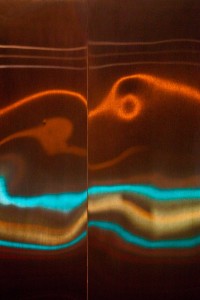Craig Richards and I were talking at the Whyte Museum of the Canadian Rockies about the revolution in color print permanence since the year 2000. (See “Will it Last?”) Our conversation led me to appreciate the range of new digital tools that enable photographic artists to have a more dramatic and yet finer set of controls over the image than ever before.
This isn’t about camera features. I’m interested in what the photographic art world calls the “controls” – metaphorically the palette of levers I can pull to create an intended artistic result.
Here are my top ten:
1) Permanence: Permanent, pigment-based, color and black & white prints – my #1 by a wide margin!
2) Size: The ability to make large prints. I can print 44in. (111cm.) high by as long as the roll of paper in the printer. Most silver darkrooms were limited to 16x20in. (40x50cm.) images or smaller.
3) Impact: Tremendous range and strength of print colors and range and nuances of B&W tones
4) Control: The ability to regulate the finest nuances of a color or b&w print or distort the qualities of the image in extreme ways.
5) Mobility: The great light sensitivity of digital cameras combined with image stabilisers that reduce shake when hand holding a camera. Together these create the ability to make images under circumstances impossible with non-stabilized, film cameras.
6) Surface: True matte papers with wonderful surface textures and luminosities. Prior to digital printing a truly matte surface on a fine art paper could only be obtained by processes so specialized only a very few artists ever attempted them. We also have a wealth of papers with satin, lustre and high gloss surfaces and can print on canvas and metalized material as well.
7) Detail: The joining or “stitching” of numerous small images to seamlessly create huge pictures or panoramas of incredible detail.
8) Dynamic Range: The ability to combine long and short exposures to capture detail in a scene right from the most brilliant highlights to the deepest shadows. This is call High Dynamic Range (HDR) imaging.
9) Depth of Field: The ability to combine images to bring everything into focus from the closet objects in the picture to the most distant. (Extended Depth of Field or EDF imaging.)
10) Seeing or previsualization support: The ability to preview an image roughly on the camera back and then, less approximately, on the computer monitor.
Yes –some of these things predate digital. I’ve pulled Polaroids as an aid to seeing, used compensating development to achieve a type of HDR and physically joined series of prints together to create panoramas. Digital has made what was difficult, limited and chancy into elements of the photographic artist’s palette that can be used with facility and confidence.
I’ve heard the digital revolution criticized for ruining photography as an art by making it too easy. The same criticism was offered when the first Kodaks and swept the market with the slogan, “You push the button and we do the rest.” This criticism wasn’t valid in 1890 and isn’t now. Good photography is all about good seeing and feeling. Yes – there is enough ordinary photography to fill the Pacific Ocean. It doesn’t matter. Our revolutionary new tools give flight to the best artists among us, those who reveal the world with an extraordinary eye and deep emotional connection.

Hi Bill,
Thanks for the link to your blog. I will check it out over time, but I feel pretty good about the initial impression. And you know what they say about first impressions.
W.
Good job on your blog site … Your images have often been inspirational to me, now so are your words.
Thoughtful….intelligent….and informative.
Just the sort of thing I’ve come to expect from my friend Bill.
George Webber